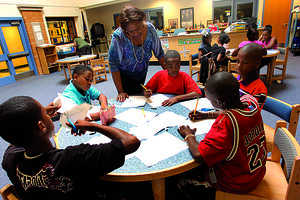Public-school losses: private schools' gain
As public school teachers face what may be the longest string of layoffs ever, the private sector gets a boost. Transport and janitorial contractors, online tutoring companies, and private schools are among those seeing a more talented workforce or an uptick in business.

Incoming fifth-graders get language, reading, and math lessons in a library in Gary, Ind. Many other summer programs in the district have been canceled due to budget constraints.
Stephanie Dowell / The Post-Tribune / AP / File
If there's a silver lining to the unprecedented teacher layoffs now taking place in America's public schools, it lies in places like Baylor School, a private school for sixth- through 12th-graders in Chattanooga, Tenn.
The applicant pool to teach at Baylor has become larger and stronger, says Scott Dering, the school's dean of academics. Even though four of his new hires haven't started teaching yet, he is already bragging about them.
"We're getting an all-star team of public school teachers," Mr. Dering says.
For the first time since the government began keeping track in 1955, the number of workers in America's public schools has fallen two school years in a row. And it's likely that the 2011-12 school year will mark a third year of decline, perhaps the biggest so far. For instance, the state of New York, which lost about 10,000 public education employees in the past two years, will lose another 12,000 or so in the coming school year, according to New York State United Teachers, a federation of education employee unions.
Cuts in faculty mean bigger class sizes, fewer course offerings, and less individual attention for students. Public schools will struggle to maintain their education standards. But the loss of public school teachers may prove to be a boon for the private sector. While the number of public school workers dropped 2.6 percent between June 2009 and June 2011, the number of private education service workers has grown proportionately – 2.8 percent.
"Look at how the public sector is cutting back," says Peter Upham, executive director of The Association of Boarding Schools, based in Asheville, N.C. "Comparatively, our packages are more competitive."
Boarding schools have become more attractive, especially with the lure of free housing for teachers. Test-prep companies are on the rise, as are charter schools and online tutoring.
For instance, Tutor.com, a company that provides on-demand, online tutoring for K-12 and some college students, is increasing the number of school districts it contracts with. The number of people who want to work for the New York-based company has skyrocketed. In 2009, its waiting list of tutors ready to teach had about 4,400 people; now, it has more than 14,000.
"There's more general awareness that this [option] exists for teachers," says Jennifer Kohn, spokeswoman for Tutor.com. Most of its tutors are teachers who have left the classroom or those who want extra part-time work.
While private education outlets are seeing increased interest from public school teachers, many laid-off teachers are looking beyond education.
Cherine Akbari, a former broadcast journalist, had spent just a year teaching social studies to 10th- and 11th-graders in Broward County, Fla., when she was laid off in May, about a month before the end of the school year. The district has let go of 1,400 teachers so far this year – including five social studies teachers at Ms. Akbari's school, although some expect to be hired back.
While Akbari hopes to keep working as a teacher, she's also applying for communications jobs. "I can't wait forever," she says. "I just bought a house. I have a mortgage to pay."
Some laid-off public school employees, especially younger ones, make very competitive candidates in fields outside education, says Scott Hicks, of New York State United Teachers, who has run finance workshops for more than 1,000 employees laid off from the state's education system. "Many of them are seeing it as the termination of their career," Mr. Hicks says. But "they can compete on the open market for other jobs."
It's not just laid-off employees who are turning to the private sector; public schools themselves are also contracting out services usually performed by staff.
The Sparta, Mich., school district decided this summer to cut 21 positions in its transportation department and contracted with a private company instead. In Vincennes, Ind., the school district will expand its contract with the company that already supplies its food, Sodexo, to do custodial, maintenance, and grounds services as well.
While schools will undoubtedly lose good teachers because of the cuts, a few years of layoffs shouldn't cause a lasting shortage of teachers.
"There's always been chronic high turnover," says Richard Ingersoll, a professor of education and sociology at the University of Pennsylvania in Philadelphia.
Typically, 1 in 6 teachers leaves or moves between schools each year, and nearly half leave the profession within the first five years. Since young teachers are the most likely to leave and are typically the target of layoffs under "last in, first out" policies, public schools aren't likely to lose their most experienced faculty.
The difference this time is that, while many young teachers will be leaving, fewer newcomers will be taking their place.
"You're jettisoning some really good teachers, some of whom will never come back," Mr. Ingersoll says. "And that's a negative, because really good teachers don't grow on trees."
